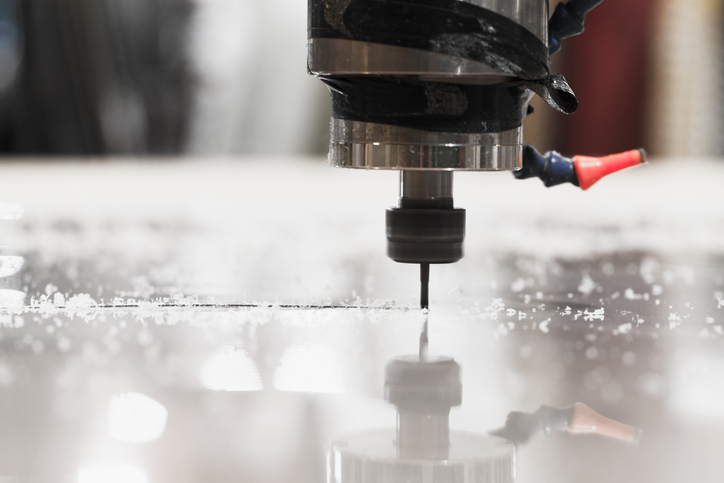The aerospace industry depends on lightweight, tight-tolerance components that maintain mechanical strength at extreme temperatures and pressures. These desired properties have led many engineers to convert metal components to high-performance and engineering plastics. CNC machining is the preferred method for achieving the precision needed.
Benefits of CNC Machining for Aerospace Applications
CNC machining is a subtractive process that uses computer-guided multi-axis tools to remove material from a workpiece to create the desired shape. The process can start with a block of plastic or near net shapes—close in size and shape to the finished product—and then machined to achieve desired features and tolerances. High-performance and engineering plastics tend to be more expensive than commodity plastics, so starting with a near-net shape reduces material waste.
Critical applications in aerospace face demanding environments where failure is not an option, and accuracy and precision are imperative. CNC machining is a chosen manufacturing method because it offers many benefits, including:
- Maintaining Tighter Tolerances – CNC machining often achieves tighter tolerances than injection molding and other processes.
- Being Cost-effective – Machining can be cost-effective for small to moderate runs since no special tooling is required.
- Achieving Complex Geometries – CNC machining gives part designers more flexibility with part geometry.
- Providing More Material Choices—Some materials that are difficult to injection mold, such as ultra-high molecular weight polyethylene (UHMWPE) because of its low melting point, can be machined, providing a greater selection of materials to choose from.
While CNC machining can produce tight-tolerance plastics, in some cases, plastics can be more challenging to machine than metal because of their plasticity and susceptibility to deforming from the heat generated. It is imperative that you work with CNC machinists with experience in machining high-performance and engineering plastics.
Why Plastics for Aerospace
Reducing the amount of petroleum required to operate aircraft is a critical consideration for both military and commercial airlines. Fuel accounts for over 20 percent of airlines’ operating expenses, amounting to billions of dollars annually for a single airline. Lightweighting components by converting metal to plastic can result in considerable savings. While many factors influence fuel efficiency, one airliner reduced the weight of its aircraft by 20% and experienced a 10%–12% fuel efficiency improvement. CNC components tend to be smaller, so alone may not make a significant impact, but they can contribute to an overall weight reduction strategy.
The high-strength-to-weight ratio is a primary driver for the use of engineering and high-performance plastics, but many other properties are also sought-after, including impact, vibration, corrosion, and chemical resistance, as well as compression strength and self-lubricating characteristics. The structural properties of high-performance thermoplastic can be enhanced with the addition of glass fiber, carbon fiber, or other materials.
However, material properties vary from polymer to polymer, and the material chosen will depend on the component’s functional, environmental, and longevity requirements. The component may need to maintain structural integrity under heat and pressure, or be non-conductive, or have chemical resistance, for example. When choosing a polymer, it is important to consider every situation the component will encounter. In addition, components in aircraft interiors must comply with fire regulations, meeting specific requirements for flame resistance, smoke generation, and toxicity.
Some common materials used in aerospace applications include:
- PEEK (polyether ether ketone) is a popular material to replace metal in the aerospace industry because of its properties – lightweight, mechanical strength, high-temperature resistance, and creep and fatigue resistance. It is used in components throughout the aircraft, including those in fuel systems, engines, interior, and flight controls.
- PPSU (polyphenylsulfone) is lightweight plastic with high heat, chemical, and impact resistance. It is FDA-approved for food contact and can be polished to a mirror finish, making it ideal for precision components in the aircraft’s interior.
- PI (polyimide) is a dimensionally stable, temperature-restraint plastic that is able to operate in temperatures ranging from cryogenic to 550°F. Its high friction and wear resistance make it ideal for use in high-temperature and high-speed bearing and wear applications.
- PVDF (polyvinylidene fluoride) is a plastic with chemical resistance, good thermomechanical and tensile strength, flame resistance, and durability in extreme conditions. Machined PVDF components are found in pipe fittings, manifolds, or connectors.
- PEI (Polyetherimide ) is a high-performance plastic with outstanding mechanical strength, heat resistance, and flame retardancy. Its high dielectric strength makes it a great electrical insulator. It is also resistant to hot water and steam and is FDA-approved for food contact, making it ideal for galley equipment such as ovens.
- PAI (polyamide-imide) is a dimensionally stable engineering thermoset plastic with exceptional strength and impact resistance. It is resistant to chemicals and flame and is a good electrical insulator. PAI is used in structural, wear, and electrical aerospace applications.
- PBI (polybenzimidazole) offers impressive high-temperature mechanical properties, and it is used for components in aircraft engines and other high-heat applications.
Choosing an Experienced Partner
The critical nature of many aerospace components means care must be taken to select a partner that can machine them to tight tolerances and exact specifications. Ensinger’s team are high-performance plastics experts with the experience to navigate challenges that may occur when machining plastics. We use cutting-edge CNC equipment dedicated to producing precision CNC machined plastic parts.
In addition to machining, we can assist with part design, material selection, design for manufacturability analysis, injection molding, and advanced post-molding services. We will evaluate your part to determine the best manufacturing process or combination of processes to provide the highest quality component and the best cost.
Contact us to get started on your precision plastic components.
